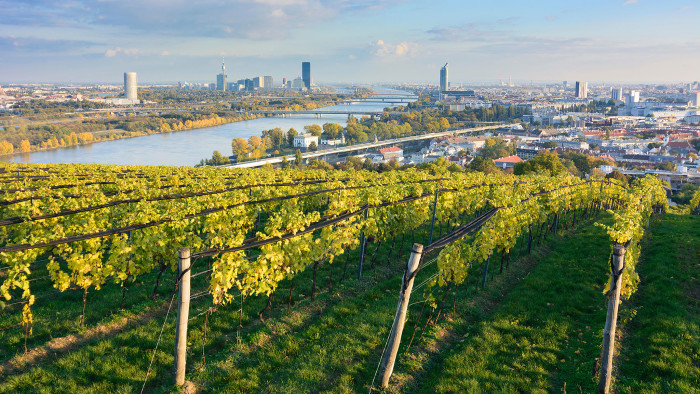Vienna’s vine romance with homegrown wine

Roula Khalaf, Editor of the FT, selects her favourite stories in this weekly newsletter.
As a young man taking over his father’s vineyards, Fritz Wieninger was ready to kill off Gemischter Satz. It was a simple wine served by the pitcher and better known for quantity than quality.
Then he had an “aha” moment when he tasted a fine bottle of Gemischter Satz from a vineyard his family had just purchased in Nussberg, in Vienna’s 19th district. It is the area where Beethoven strolled when composing his Eroica symphony.
That was in the late 1990s, and Mr Wieninger decided to revitalise a traditional blend of wine almost synonymous with Vienna. By 2013, the Vienna Gemischter Satz blend had its own Districtus Austriae Controllatus region-specific quality designation.
Mr Wieninger’s push to bring quality back to Vienna’s wines could not have come at a better time. The city’s 600-plus hectares of vineyards were falling on bad times, hit by urban encroachment and a 1985 scandal in which some growers were caught adding antifreeze to their wine.
The city and its residents boast that Vienna has the largest urban vineyards in the world, and Gemischter Satz is not the only wine produced in the capital. Grüner Veltliner and Riesling are popular whites; Zweigelt is the most prominent red.
Wine is deep in the city’s culture, along with the cozy Heurigen, simple taverns run by the growers, serving traditional Austrian cold meat platters and potato salad.
While the quality of Vienna’s wine has improved, new pressures have emerged. Running a vineyard on the edge of a metropolis of 1.8m people is not easy, as urbanisation eats into precious farmland. The value of land in the wine-growing regions, which make up some of the city’s most desirable real estate, has increased tenfold in the past 10 years.
Land zoned for construction can sell for €3,000 per square metre, but agricultural land is priced at only €35 per square metre.
It is not uncommon to see a small vintner surrounded on all sides by housing developments. Farmers must navigate their tractors between buildings to reach fields, many of which are no longer connected to one another.
Robert Steidl, head of the Department of Enology at Austria’s College for Viticulture and Pomology, calculates that it costs about €2.25 to produce a litre of Viennese wine, compared with about 60 cents for a litre made in nearby Weinviertel.

Residential development does not mix well with farming. The new neighbours complain about the slow-moving tractors on the streets; their noise disturbs the idyllic countryside and dust is kicked up by the machinery. Then there is the smell of the ripening compost on the organic farms — some 30 per cent of Viennese wines are grown organically.
“Everyone wants the garden and beautiful scenery, but no one wants the dirt,” Mr Wieninger notes drily.
They do enjoy the wine culture, however. Vienna’s relationship with wine dates back to the 12th century, when the growers came to appreciate the region’s chalky soil and mountain-sheltered climate.
Because most of the vineyards are planted along the rim of the Vienna Woods, the Viennese love to spend a Sunday afternoon walking through the forest and stopping at Heurigen. About half of the 1.9m litres of wine produced in Vienna annually are consumed in the taverns.
“I associate Heurigen completely with Vienna,” along with opera, the waltz and gala balls, says Maria-Regina Kecht, a German studies professor. The Viennese have their favourite Heurigen. While some, such as Prof Kecht, say the best are to be found in Grinzing and Nussdorf, others argue that these have become too touristy. The taverns in Stammersdorf and Gumpoldskirchen are more authentic, they believe.
Mr Wieninger, whose brother runs a heurigen in Stammersdorf, says that in spite of the headaches associated with wine growing, he is confident that the industry will continue.
“Wine is too important for Vienna’s image,” he says. “It’s part of our character and identity.”
Mixed fortunes of a Viennese blend
While many non-German speakers have difficulty pronouncing Gemischter Satz (said Gemishter Zatz), few struggle to enjoy a glass.
The fruity dry wine, whose name means “mixed set”, has been a Viennese staple for centuries, but it has not always been palatable. A particularly acidic harvest in the 12th century was so odious that it was supposedly used in mortar to build St Stephen’s Cathedral.
To earn the DAC quality label, Vienna Gemischter Satz vintners must grow at least three white grape varieties in the same field, though some mix 10 or more. The grapes are harvested, pressed and fermented together, giving the wine a taste, aroma and substance different to a cuvée blend.
“With Gemischter Satz the grapes are mixed. With cuvée, wines are mixed,” says Robert Steidl, head of the Department of Enology at Austria’s College for Viticulture and Pomology.
The method was originally meant to minimise the risk from the weather. Rain or a heatwave that devastates one grape variety will not harm another that blooms later.
Mr Steidl is untroubled that visitors struggle to pronounce Gemischter Satz. They eventually got their tongues around the more famous Grüner Veltliner wine.
Comments